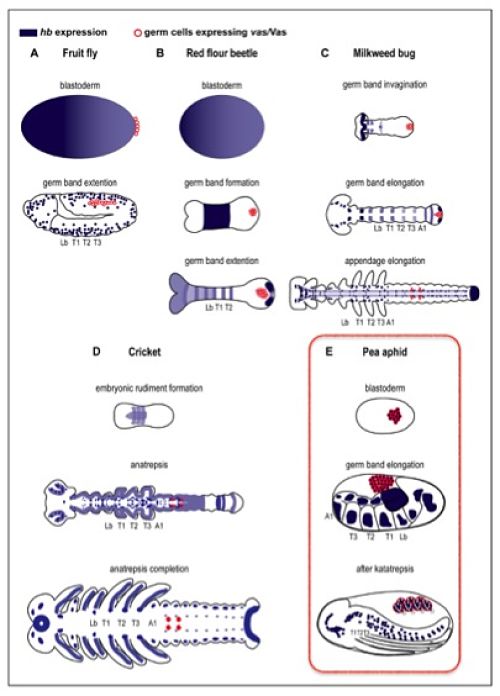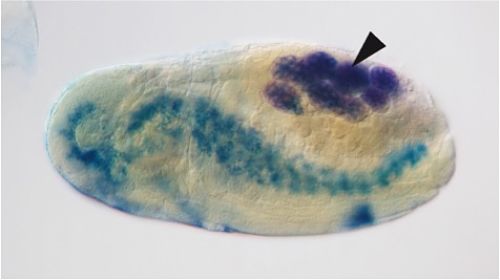動物界首例!蚜蟲生殖細胞中「鐘樓怪人」基因的發現為病蟲害防治帶來曙光
動物界新發現!台大昆蟲系遺傳發育研究團隊近期研究發現,蚜蟲的生殖細胞中擁有「鐘樓怪人」基因(hunchback)之表現,研究團隊主持人張俊哲教授表示,若再解析蚜蟲基因,將有望研發出阻礙蚜蟲特殊繁衍的方法,成功防治蚜蟲帶來的病蟲害。
張俊哲指出,蚜蟲素有「植物的蚊子」之稱,以刺吸式口器吸取植物汁液,同時於植株間傳播病毒,危害農作物健康甚鉅,而其特殊的「孤雌胎生」(蚜蟲卵未受精即在母體內發育成熟)繁衍方式便是主因之一。張俊哲表示,此次的研究主角「鐘樓怪人」基因,一般表現於頭部和神經細胞,舉凡果蠅、蜜蜂、甲蟲、椿象、蟋蟀、蜘蛛、蚜蟲等皆不例外。因此,當他與第一作者鍾成侑和蕭逸旻首度看到表現於蚜蟲生殖細胞當中的「鐘樓怪人」基因時更一度懷疑實驗結果的真實性。

圖一:「鐘樓怪人」基因在數種主要模式昆蟲的表現比較。(摘錄自期刊原文最後一圖。A:果蠅;B:擬榖盜;C:椿象;D:蟋蟀;E:蚜蟲(以紅色方框特別標示)。藍色為鐘樓怪人基因表現的位置,紅色為生殖基因vasa 的表現所在。由圖顯示,只有蚜蟲的生殖細胞,有鐘樓怪人基因的表現。)
研究團隊表示,經多次實驗驗證後終於證實,「鐘樓怪人」基因在蚜蟲體中既可表現於神經細胞,又可表現於發育中的生殖細胞,且從頭到尾都專一表現於其中。此一研究成果打破原先大家對「鐘樓怪人」僅表現於神經的既定印象,對這個基因的演化發育角色,開啟新頁。
至於為何蚜蟲會有如此特別之表現類型,研究團隊推測,這和蚜蟲的「孤雌胎生」繁殖方式有關。蚜蟲生殖細胞需預先儲備「鐘樓怪人」基因的產物,以利它們在「由卵轉胚」的第一刻,馬上撐起前端發育的重責大仼,以免蚜蟲出生後呈現「鐘樓怪人」的佝僂體態。

圖二:「鐘樓怪人」基因在蚜蟲成熟胚胎的表現。除了表現在頭部和神經系統(淡藍),鐘樓怪人基因也表現在背部的生殖細胞(深紫色,箭頭所指之處)。
張俊哲教授說,若能將基因功能解析工具運用於蚜蟲,將有利於研發阻絕蚜蟲「孤雌胎生」繁衍的方法,且能不傷及其他的昆蟲與動物,達生態保育之效,並有效防治蚜蟲造成之病蟲害。
(此一研究成果將收錄於12月號的【昆蟲分子生物學(Insect Molecular Biology)】期刋,由英國皇家昆蟲學會發行。)
şişli escort
mecidiyeköy escort
şişli escort
taksim escort
ümraniye escort
şişli escort
istanbul escort
Discovery of "Hunchback" Genes from Aphid Germ Cells Brings New Dawn to Pest Control
Professor Chun-Che Chang at the Department of Entomology found that the germ cells of aphids express the "hunchback" gene. Professor Chang said that if the genes of the aphids were further analyzed, it would be possible to develop a barrier to their parthenogenetic reproduction. The method would successfully control the pests and diseases caused by aphids. Professor Chang pointed out that aphids were known as the "plant mosquitoes." They used piercing and sucking mouthparts to suck plant sap. At the same time, they spread viruses between plants and endanger the health of crops. Professor Chang said that the protagonist of this study, the "hunchback" genes, were generally expressed in the head and nerve cells of insects, including fruit flies, bees, beetles, stink bugs, crickets, spiders, and aphids. Therefore, when they saw the "hunchback" gene expressed in the germ cells of aphids, they originally doubted the authenticity of the experimental results.
.jpg)
Figure. Comparison of the "hunchback" gene performance in several main model insects.
şişli escort
mecidiyeköy escort
şişli escort
taksim escort
ümraniye escort
şişli escort
istanbul escort